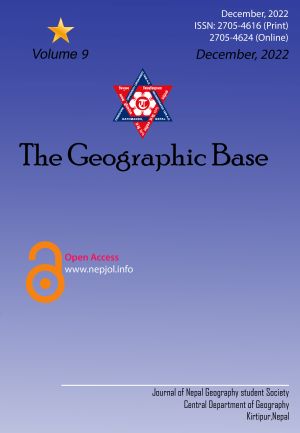Comparative Study of Flood and Long-term Mean Monthly Flow Estimation Approaches: Case Studies of Six Basins in Nepal
DOI:
https://doi.org/10.3126/tgb.v9i1.55425Keywords:
Return period, Peak flood, Monthly flow, Frequency distribution, Flood computational techniqueAbstract
Most of Nepal's river basins have poor hydro- meteorological databases, with several river basins being ungauged. Thus, hydrological parameters need to be estimated using different types of computation methods. The primary goal of this study is to identify the most accurate method for calculating peak flood and long-term mean monthly flow among the most commonly used methods in Nepal. We compared the peak flood calculated using various flood computation formulas, such as Hydest, Modified Hydest, MHSP (Medium Hydropower Study Project) 1997, Modified Dickens, PCJ (Prem Chandra Jha) 1996, Rational, and Specific Discharge, to the flood calculated using gauged discharge data frequency analysis. We find that it is wise to use the Modified Hydest method in the khokana basin for all Return Periods (RPs) and in the Belkot basin (for RP ≤ 100 years), the Specific Discharge method in the Jamu basin, the MHSP 1997 method in the Belkot basin (for RP ≤ 100 years) and the Bagasoti Gaun basin (for RP ≤ 20 years). The PCJ 1996 method having the lowest cumulative value of Root Mean Square Error (RMSE) for the six studied catchments is suitable for Rabhuwa Bazar (for RP > 50 years) and Bagasoti Gaun (for RP >20 years). Similarly, the Modified Dickens method is suitable in the Bagasoti Gaun basin for RP ≤ 50 years. This paper also shows the performance of the Hydest and MHSP 1997 mean flow estimation methods and suggests different coefficients or constants to be used with the MHSP 1997, Modified MIP (Medium Irrigation Project), and Hydest methods to obtain more reliable long-term mean monthly flows. Overall, our study will help the designer choose a reliable method for design flow estimation. This study also shows that the flow obtained from even the most suitable methods needs to be adjusted. As a result, intensive research is required to adjust previous methods and develop the new one.
Downloads
Downloads
Published
How to Cite
Issue
Section
License
© Nepal Geography Student Society




